Journal of
eISSN: 2573-2897


Mini Review Volume 3 Issue 3
Southern Federal University, Russia
Correspondence: Larisa Urnysheva, Southern Federal University, Russia
Received: April 25, 2018 | Published: June 7, 2018
Citation: Urnysheva L. Magna troy: military sepulchres. J His Arch & Anthropol Sci. 2018;3(3):472-476. DOI: 10.15406/jhaas.2018.03.00120
The textual and iconographic analysis of the sepulcher’s description and of the burial images in the Medieval Latin and Russian versions of the Story of Troy by Cuido de Columnis is the subject of the present paper. The catalogue of the miniatures with the forms of the sepulchers is composed. Representations of the cadaver two-tier Hector’s mausoleum and funerary icon images of Achilles in the sanctuary and Paris in the temple of Juno are fixed.
Keywords: troy history, medieval chronicle, illuminated manuscript, burial practice, text and image
The Latin text of the medieval History of Troy’s Destruction by Guido de Columnis1 consists of a prologue, thirty five books or Libers and an epilogue. The first three books are the medieval Argonautica, the next book is the fall of the Laomedon’s Troy, the next twenty six books are the story of the Priam’s Troy and the last five are the Greek exodus from the Trojan Terre after the Fall of Troy. The Old Russian illuminated version of the Story1 conforms to the Latin text and Russian book can be divided on the glosses or the texts between two successive pictures describing the act of the first miniature. Each textual passage is illustrated by picture. The present paper’s catalogue of pictures containing funeral subjects starts from the burial of Theutran, king of Messana (Liber XIII) to the burial of Thelamon Ajax (Liber XXXI). The Latin text of the Story describes briefly the funerary Greek and Trojan rituals and the Russian illuminated version of the History demonstrates the images of the stone coffins or of the mortuary monuments. The corpses were placed inside the tombs constructed for these purposes from the stone, buried in the ground or placed in the sanctuary of the temples. The Greek rectangular form of the coffin is the same as the Trojan tomb. The funeral and burial practice is described in detail only for the mummification of the Hector’s body and the creation of his two – tiered tomb, a cadaver effigy tomb.2 The sculptural effigies of the cadaver on the lower level and of the person in life on the upper level are the principal elements, an architectural idea of the medieval two – tiered royal tombs, as the funeral monuments of Louis XII and Anne of Brittany, of Francis I and Claude of France, in Basilica of Saint Denis.3 The two tired tomb is a representation of life on the upper part and representation of the afterlife on an arcaded enclosure or the small chapel of the lower level of the tomb opening at the sides. A cadaver tomb or transi is a type of gisant (recumbent effigy tomb) featuring an effigy in the macabre form of a decomposing corpse. The cadaver tombs were peculiar to Northern Europe from the late fourteenth through the seventeenth centuries.4
Hector’s sepulchral monument is created as a mausoleum for the embalmed hero’s body in the sitting pose on the lower level of the tomb. At the top level was a sculpture image of the hero in a pose of military glory. The sitting mummy of Hector in the closes of Trojan noble, preserving all the features of the living Hector, is an architectural element of difference from the royal medieval cadaver tombs. The noble Greek warriors were buried in the stone coffins in the ground except Achilles. The burial of Achilles, Greek hero, was in the sanctuary of the Thymbraean Apollo2 and the painter with oil color imaged the form of Achilles. The iconic portrait of Achilles was in the Trojan sanctuary.
The burial of Paris, the second son of Priam by Hecuba, was in the Temple of Juno and iconic portrait of Paris was placed in his sanctuary. The types of the funerary ritual in the text of History include the practice of cremation on open fires for the Greek soldiers and in the special incinerator for the Thelamon Ajax.
“Introitus autem et exitus ciuitatis ipsius fuit in sex ianuis institutus, quarum una Dardanides, secunda Tymbrea, tercia Helias, quarta Seca, quinta Troyana, et sexta Anthenorides vocabantur. Quelibet portarum ipsarum bellicosis fuerat firmata turribus per latera et in celaturis marmorearum imaginum circumquaque decora.” (Liber V, fol. 25r)
“Входъ же и исходъ града того шестию враты оустроенъ, ихъ же первыя Даръданидесъ, вторые Тембрея, третьие Елеясъ, четвертые Тетасъ, пятыя Трояны, а шестые Антоноридесъ нарицахоуся. Кая ждо бо вратъ техъ бранными беша стрелницами оукреплена по странамъ и резию мраморныхъ образовъ всюду окрестъ оукрашена.” ( LLS W 1:131, Fol. 619)
1Chronograph - Museum Miscellany, SHM, Department of Manuscripts, Museum Collection, 354 Facsimile edition of the illuminated handwritten miscellany from the collection of the State Historical Museum, as the part of many volumes illuminated Chronograph or Corpus of the World History.
2The sanctuary outside of the wall gate Tymbrea. Description of the second Troy’s exterior: “In length and in breadth the city is three days’ journey. It has six towered gates”.
Latin text is citied from the Griffin’s edition of Guido de Columna, is divided on the books, Liber I – XXXV. The sign of pagination is “fol.” Russian text and images are originated from the illuminated Chronograph or Corpus of the World History. The sign of the manuscript pagination is “Fol.”
The Liber XIII of History is the apocryphal story about Greek expedition to Messana, the ancient city constructed by the tsar Messa in the own name. The Greek leaders sent Achilles and Theleph, son of Hercules, who was a brave soldier of the Greek army, to naval expedition with three thousand warriors and the great number of the ships, from Thenedon5 to rich peaceful city of Messana for secure a continuous supply of food for the Greek military campaign against Troy and Theutran, rex of Messana, was mortally wounded by Achilles during the landing of the Greek warriors to the Messa’s coast. The conflict between the Greeks and the inhabitants of Messana was ended by peace, because Hercules was defender of Theutran against enemies in the ancient time. The noble people of Messana buried Theutran in the stone precious marble tomb (tumba, in Latin; гробъ, in Russian) with the engraving inscription. The epitaph narrates about the mortal attack of Achilles to Theutran and about letter of the possession of the royal Messana’s scepter and diadems to Theleph, son of Hercules. Epitaph: the first line of epitaph: The King Theutran lies here: Rex Theutran iacet hic: Царь Теоутранъ лежитъ зде; the second line: He was killed by Achilles mortally: quem morte peremit Achilles: его же смерьтию скончя Ахиллесъ; the third line of epitaph: He hands down the royal scepter to hold for Theleph:
Qui Thelefo regni sceptra tenere dedit: Иже Телефоу царьства скипетръ держати предастъ.

Figure 1 Burial of King Theutran. Description of picture: Top left: Theutran dictates the charter of legacy, below left: master covers the epitaph (fol. 62r): Rex Theutran iacet hic, quem morte peremit Achilles, Qui Thelefo regni sceptra tenere dedit, Below right: sepulcher of Theutran, Liber XIII, Fol. 711 (LLS W, 1, 315).
Burial of patroclus (Liber XVI)
Patroclus, friend of Achilles, was send by Agamemnon from Athens to Delos for Apollo oracle about future of the Greek - Trojan War. This expedition was headed by Achilles. Patroclus was slain by Hector during the second battle. Sepulcher from decorative marble stone; burial was hidden by the firm security.
Burial of prothesilaus (Liber XVI)
Prothesilaus, duke of Phylarca, was slain by Hector during the first battle and was buried during the truce after the second battle.
Burial of cassibilanus
Cassibilanus, the illegitimate (natural) son of the King Priam, was killed by Thoas, king of Chalcedon, was buried in the temple of Aphrodite (Venus) (Liber XVI).
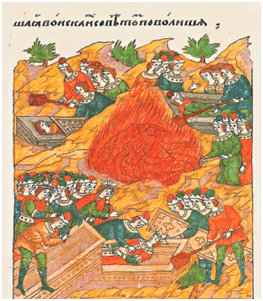
Figure 2 Burial of Patroclus, the Greeks sepulcher after the second battle. Description of picture: Below: burial of Patroclus, Top: burials of the Greek military nobles, In the middle-cremation of the other warriors, Liber XVI, Fol. 734v (LLS W, 1, 460).
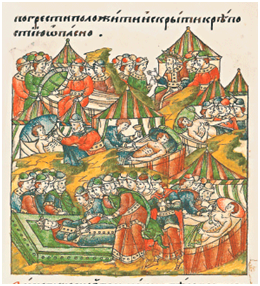
Figure 3 Burials of Prothesilaus. Prothesilaus. Description of picture: Below left: burial of Prothesilaus in cenothaphio marmoreo, Below right, to the middle: the treatment of wounded warriors, Liber XVI, Fol. 735 (LLS W, 1, 461).
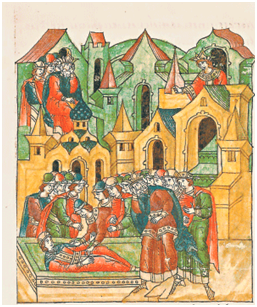
Figure 4Burial of Cassibilanus, The Trojans sepulcher after the second battle. Description of picture: Top left: Priam mourns the Cassibilanus death, below: the sepulcher of Cassibilanus, the temple of Venus is behind. Top right: Cassandra, Liber XVI, Fol. 735v (LLS W, 1, 462).
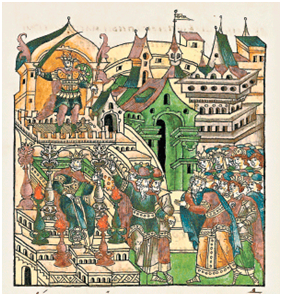
Figure 5 Burial of Hector. Description of picture: The two-tiered sepulchral monument of Hector, the four icon lamps (left), the architectural scene side with temple of Apollo. The masters show to Priam the Hector’s body and effigy (right). The Trojans behind Priam, Liber XXII, Fol. 836v (LLS W, 2, 94).

Figure 5a (A) Hector‘s anniversary days. Description of picture: The Achilles’ enter to Troy during the Anniversary days of Hector (left), Hecuba and Polixena with Trojan women before the Hector sepulchral monument (right), the marvelous preservation of Hector’s body, Liber XXIII, Fol. 846 (LLS W, 2, 113).
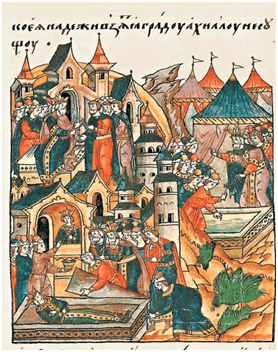
Figure 6 Burial of Achilles. Description of picture: Top left: Greek ambassadors before Priam ask to bury Achilles in the city Troy, in the middle right: the Greek camp, Agamemnon, masters construct precious tomb for Achilles. Below left: sepulcher of Achilles, sanctuary of the Thymbraean Apollo, painter with oil color image the form of Achilles, Liber XXVII, Fol. 889v (LLS W, 2, 200).
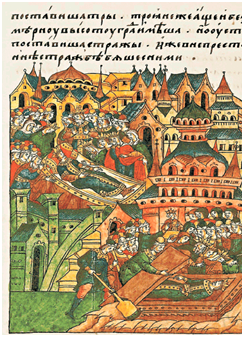
Figure 7 Burial of Paris. Paris Temple of Juno, Description of picture: Top: architectural side, mortal Paris on the bed, below: burial of Paris. Temple of Juno. Painter imaged the icon of Paris, Liber XXVII, Fol. 895 (LLS W, 2, 211).
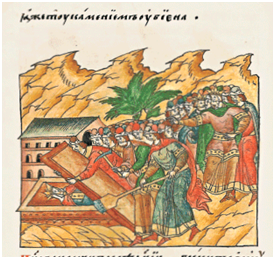
Figure 8 Burial of Hecuba. High precious monument, the Greeks buried Hecuba on the island Aulide, the place was named: location of the beginning of Trojan War: Latin: locus infestus Russian, Liber XXX, Fol. 937v (LLS W, 2, 296).
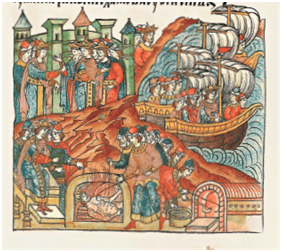
Figure 9 Cremation of Thelamon Ajax. Thelamon Ajaks, The body was cremated by request of Pirrhus, Liber XXXI, Fol. 941 (LLS W, 2, 303).
Abbreviations: fol, sign of pagination of Latin text; Fol, sign of pagination of Russian text; LLS W1, sign of the electronic edition of Russian Chronograph, part 1; LLS W2, sign of the electronic edition of Russian Chronograph, part 2.
Burial of hector (Liber XXII)
Hector was the first-born son of Priam, king of Troy, by Hecuba, husband of Andromache and father of Laumedontam and Astionacam. Hector, the chief hero of the Trojans in their war with the Greeks, Hector was killed by Achilles during the eighth battle, was sepulchered in the temple of Apollo in the two – tiered tabernacle. The description of the burial two-tiered monument of Hector begins from the Priam’s looking for masters: architects, sculptors, scientists. The elements of construction are pedestal, four gold columns with decorated carved bases and capitals, gold vault with plinth, steps before monument. The upper part of pedestal and the vault form the interior space of a small temple, in which the embalmed body of Hector seated on the throne, open for looking. The sculpture of the Hector with sword is on the upper level of the sepulcher monument. The construction and architecture of the burial tabernacle realized the Priam’s desire for preservation the body of Hector without decomposition and decay and without coffin’s confinement.5−10
Dares Phrygian, De filiis itaque regis Priami nullus fuit qui tanta animositate vigeret sicut primogenitus eius Hector. Hic fuit ille qui suo tempore omnes alios in uirtutis potencia superauit. Parum uero erat balbuciens in loquela. Habuit membra durissima, sustinencia pondera magna laborum. Magnus erat in forma. Nunquam tanti uigoris uirum Troya produxit neque magnanimum, multa repletum nube pilorum. Nunquam uerbum iniuriosum aut indecens ab ore eius exiuit. Nunquam sibi extitit tediosum laboribus incumbere preliorum. Nullis enim sudoribus bellicis lassabatur. Nunquam legitur aliquis in aliquot regno fuisse qui tantum a suis regnicolis amaretur (fol. 46r). The Trojans established fifteen days of mourning for the hero on the anniversary of his death.
Burial of achilles (Liber XXVII)
Achilles was the son of Peleus, king of the Myrmidones in Phthiotis, in Thessaly and of the Nereid Thetis, father of Pyrrhus or Neoptolemus.6 Achilles was killed by Paris in the temple of Apollo, in Troy. The first Greek embassy asks for bodies of Achilles and Archilogus, obtains both bodies and carries them to the Greek camp. The great precious sepulcher was constructed for Achilles. The second Greek embassy to Priam comes with a request to bury Achilles in Troy and is allowed to bury hero in the sanctuary of the wall gate Thymbrea. The image and the mode of Achilles were painted.
Burial of paris (Liber XXVII)
Paris was the second son of Priam, by Hecuba, was killed by Ajax, during twentieth battle (Liber XXVII). Latin: Paratur Paridi in templo Iunonis preciosa nimium sepultura, cuius forma et serie in narrandi modo postpositis. Corpus Paridis in ea reconditum extitit et humatum (fol. 109v). Russian: Оуготовляется Паридоу въ храме Юнонове нарочито зело погребение, его же образъ и чинъ въ повести оставлены. Въ немъ же тело Паридово бе положено и погребено (Fol. 895).
Burial of hecuba (Liber XXX)
Hecuba was a wife of Priam, king of Troy, was the mother of five sons and three daughters. Hecuba was killed by the Greeks after ruin of Troy, after deaths of the sons except Helen, of Priam her husband, of Polixena her daughter. Hecuba was sepulchered at Aulis.
Cremation of thelamon ajax (Liber XXXI)
Thelamon Ajax was a son of Thelamon and Exiona, daughter of the King Laomedon of Troy and sister of the King Priam of Troy. Thelamon Ajax was killed by the Greeks because of conflict about the Trojan idol Palladium.
5Dictionary: Tenedos, an island off the coast of Troas, from which its distance is only 40 stadia, while from Cape Sigeum it is 12 miles distant. (Strab. xiii. p.604; Plin. Nat. 2.106, 5.39)
6Dictionary
The text of the Troy History by Guido de Columna is inscribed in the text of biblical history after the Book of Judges, in the Russian handwritten illuminated Chronograph, that is, the events of the Greek – Trojan battles for Priam’s Troy date back to the late Bronze Age. The depictions of the tombs and two-tiered monument, funeral images of heroes in manuscript and description of the sepulcher rituals do not fined confirmation in the archaeological artifacts at the present time, but are of scientific interest.
None.
Author declares that there is no conflict of interest.

©2018 Urnysheva. This is an open access article distributed under the terms of the, which permits unrestricted use, distribution, and build upon your work non-commercially.